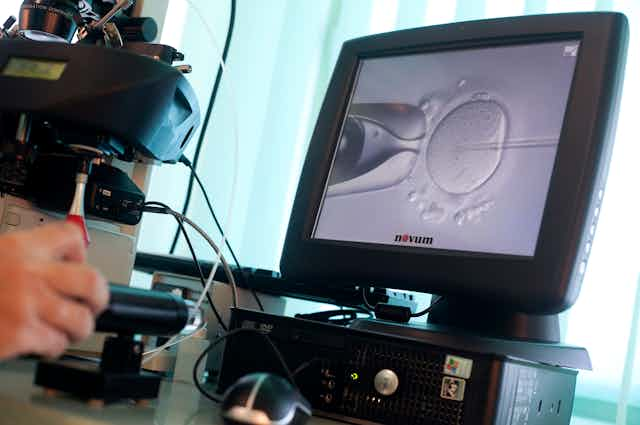Victoria’s parliament is on Wednesday debating the controversial Assisted Reproductive Treatment Amendment Bill. The government intends that its legislation, if passed, will retrospectively open Victoria’s sperm donor records so all donor-conceived people can obtain the name and date of birth of their donor, regardless of the donor’s consent. Victoria will become the first jurisdiction in the world to take such drastic action on such a large scale.
In recent weeks, donors have expressed anger about the implications of the legislation, arguing that it is an invasion of their privacy.
In response to such concerns, the bill includes the option of lodging a “contact preference”. This will enable a donor or donor-conceived person to veto contact or prescribe the type of contact with which they are comfortable. But do contact vetoes work?
What will the new law do?
The proposed law eliminates the existing requirement that someone who donated sperm prior to 1998, when anonymity was still permitted, must give his consent before his identifying information can be released. Any concerns about the privacy rights of donors created by the removal of consent are to be managed through the use of contact preferences.

A donor or donor-conceived person will have four months after an application is made to decide whether or not to lodge a contact preference. If a preference is lodged, the applicant will be required to sign an undertaking that they will comply with its conditions. If an applicant refuses to sign, information will not be provided.
Breaches of a contact preference will be a criminal offence. The penalty will be a a fine of up to 50 penalty units (about A$7583).
If a donor cannot be located within three months of an application being filed, the applicant will be given the donor’s identifying information. However, the applicant must sign an undertaking that if the donor is located, contact will not be made.
Do contact vetoes work?
Whether contact vetoes can protect the privacy rights of donors and donor-conceived people can be assessed by looking to the adoption context. Several Australian states and overseas jurisdictions have introduced laws over the past 20 years retrospectively opening adoption records. Many of those laws include the option of contact vetoes.
Research from Australia, the UK and the US on the use of contact vetoes in adoption law indicates that they are rarely breached. For example, a review of the first 12 months of the NSW adoption disclosure system found that compliance with contact vetoes was “remarkably high”, with only one breach reported. Concerns about parties breaching contact vetoes are thus largely unfounded.
While contact vetoes are typically respected, the NSW review indicated that breaches were not the only criterion by which participants judged the success of the system. The process of lodging the veto was also important.
For example, it was reported that department officials administering the veto system made some adoptees and birth parents feel uncomfortable about lodging a veto. Officials were described as critical of those who sought to put a veto in place. They were also accused of pressuring applicants to attach a message or photo to the veto.
Those who lodged vetoes also objected to having to do so in person. They felt this gave department officials an opportunity to pressure them to not lodge the veto. Others noted that ill-health or lack of mobility made it difficult to lodge a veto in person.
How should the contact veto system work?
While concerns that contact vetoes will be breached appear to be largely unfounded, the system must be administered neutrally if the privacy interests of donors and donor-conceived people are to be fully protected. This can be achieved in a number of ways.
First, the counselling that both donors and offspring have to attend if they are the subject of an application must be neutral on the question of contact vetoes. Counselling cannot be used as an opportunity to dissuade participants from lodging vetoes.
Second, those administering the system must refrain from discussing applicants’ decisions with them. Any suggestion that an applicant should change his or her mind or provide photos or other information should be understood as wholly inappropriate.
Finally, it should be possible to lodge a contact veto online or via mail, and the process should be free.
The privacy concerns of donors and donor-conceived people can likely be met by the Assisted Reproduction Treatment Amendment Bill provided the contact veto system is adequately managed. The process must be simple and free of coercion.
A system that lacks these attributes runs the risk of intruding on the privacy of donors and donor-conceived people who do not wish to participate in the new regime.

